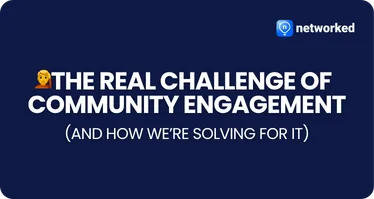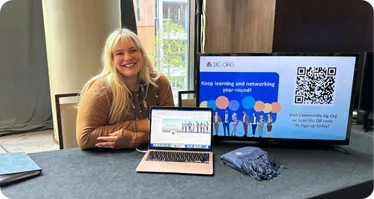Associations that are thriving in 2024 are embracing the power of online member communities. Online member communities are essential for associations because they create a space where members can share, learn, and grow together. These communities offer continuous support, exclusive benefits, and a sense of belonging.
In this blog post, we’ll explore what online member communities are, their benefits, and why they’re different from social media groups. We’ll also discuss how these communities can streamline communication within your organization and why they are crucial for the future of associations and nonprofits. So, let’s dive in and see why every association needs an online member community.

What is an Online Member Community?
Definition: An online member community is a digital space where people with similar interests, goals, or passions come together to connect and communicate. Think of it as a virtual gathering spot where members can share ideas, ask questions, and support each other.
The main goals of these communities are to:
✅ Connect Members: Bring together individuals who share common interests or experiences.
✅ Provide Support: Offer a platform for members to help each other with advice, resources, and encouragement.
✅ Share Information: Keep members informed about important topics, events, and updates relevant to their interests.
✅ Foster Engagement: Encourage active participation through discussions, activities, and events.
✅ Enhance Learning: Provide access to exclusive content, courses, and learning opportunities.
In essence, an online member community serves as a hub for interaction, learning, and growth, making it an invaluable resource for any association.
Benefits of Online Member Communities for Associations
Connection and Engagement
Online member communities create a sense of belonging by allowing members to interact with each other regularly. This constant interaction keeps members connected and engaged with the association’s activities and goals.
Examples of Common Platforms and Their Features
📌 Forums and Discussion Boards: Places for members to ask questions, share experiences, and provide support.
📌 Social Media Integration: Seamless connections with platforms like Facebook and LinkedIn for easy sharing and engagement.
📌 Live Chat and Messaging: Instant communication tools that foster real-time conversations.
📌 Event Calendars: Keeping members informed about upcoming events and activities.
Year-Round Support and Benefits
An online member community provides support throughout the year, not just during annual meetings or conferences. This includes:
Learning Courses: Access to exclusive educational content that helps members grow their skills and knowledge.
Job Postings: A dedicated space for career opportunities and job listings within the community.
Importance of Engagement Beyond Annual Events
While annual events are great for networking, they’re not enough to keep members engaged all year. Online communities fill this gap by offering continuous interaction, ensuring members stay connected, involved, and informed every day.
Overall, online member communities are crucial for better connection between members, providing continuous support, and keeping engagement levels high throughout the year.
Differences Between Social Media Groups and Private, Branded Communities
👉 Control and Security
Private, branded communities offer much more control over the environment. You decide the rules, manage the content, and ensure the community aligns with your association’s values and goals.
👉 Data Security Concerns with Social Media
Social media platforms are often subject to data breaches and changes in privacy policies. With a private community, you have full control over the data, ensuring it is securely stored and used responsibly.
👉 Access to Data
In private communities, you have full access to engagement data. This means you can track how members interact, what content they engage with, and identify trends.
Examples of Data Usage:
Personalization: Tailor content and resources to meet individual member needs.
Improvement: Use data to refine community features and address member concerns.
Growth: Identify active members who can take on leadership roles or contribute more significantly.
👉 Engagement Tools
Private communities come with a suite of engagement tools designed to keep members involved and active.
Features Include:
Forums and Discussion Boards: For in-depth conversations and support.
Gamification: Badges, leaderboards, and contests to motivate participation.
Live Events: Webinars, live chats, and video sessions to foster real-time interaction.
👉 Organizational Benefits
Online communities streamline internal communication and make organizational processes more efficient. For instance, the National Association of Nutrition Professionals (NANP) used their online community to centralize communication and document storage, saving them $1,600 annually by replacing Dropbox.
👉 Strategic Direction
Online communities help shape the strategic direction of associations by providing a direct line to member feedback. This feedback helps identify gaps in services and opportunities for new initiatives.
The Need for Online Communities in Associations and Nonprofits
Member Expectations
Recent studies show that members want digital spaces to connect with others in their association. For example, more than half of surveyed association members said it’s important to have an online community for digital networking.
However, there’s a disconnect between what members want and what associations provide. Less than 20% of association staff say they use online communities, but over a third of members wish they had this option. This gap shows a big opportunity for associations to better meet their members’ needs.
Collaboration Hub
Online communities act as a central hub where members can interact, share information, and stay updated on association activities. This centralized interaction helps foster a sense of community and belonging.
These communities complement other communication methods like newsletters, social media, and in-person events. They bring everything together, making it easier for members to stay connected and informed across different platforms and programs.
Is an Online Community Right for Your Association?
Creating an online community isn’t a set-it-and-forget-it task. It needs regular attention to thrive. This includes adding new users, moderating discussions, posting content, and organizing events.
One effective solution is hiring or recruiting a community manager. This person can dedicate their time to keeping the community active and engaging. Alternatively, a team effort can also work if different staff members share the responsibility.
For an online community to be truly effective, it should integrate seamlessly with your other technology tools. This means connecting it with your membership database, email system, and any other platforms you use.
Setting Goals, Metrics, and KPIs
It’s crucial to set clear goals and metrics to measure the success of your online community. This includes tracking engagement levels, member satisfaction, and the impact on your association’s overall objectives. Having these KPIs in place will help you understand what’s working and where you can improve.
In summary, online communities are essential for associations and nonprofits to meet member expectations, provide a central hub for collaboration, and enhance communication. However, they require careful planning, regular management, and integration with existing technology to be successful.
Conclusion
Online member communities offer numerous benefits for associations. They help members connect and stay engaged, provide continuous support and exclusive benefits, and offer better control and data security compared to social media groups. These communities also streamline communication and shape the strategic direction of associations by gathering valuable feedback. With a growing demand from members for digital networking spaces, online communities are becoming essential tools for any association looking to thrive in the digital age.
If your association hasn’t yet embraced the power of an online community, now is the time to consider creating one. An online member community can enhance member engagement, improve organizational efficiency, and help you stay connected with your members year-round.
About Networked
Networked is an innovative online community platform designed to empower creators, entrepreneurs, businesses, and organizations to build and nurture vibrant communities. Our platform combines community-building tools, content creation capabilities, opportunity sharing, and monetization options, all in one user-friendly environment.
How Networked Can Help Your Association
Networked provides everything you need to create and maintain an engaging online community under your brand. With features like forums, live events, gamification, and robust data analytics, Networked ensures your community thrives and your members stay connected and engaged.




